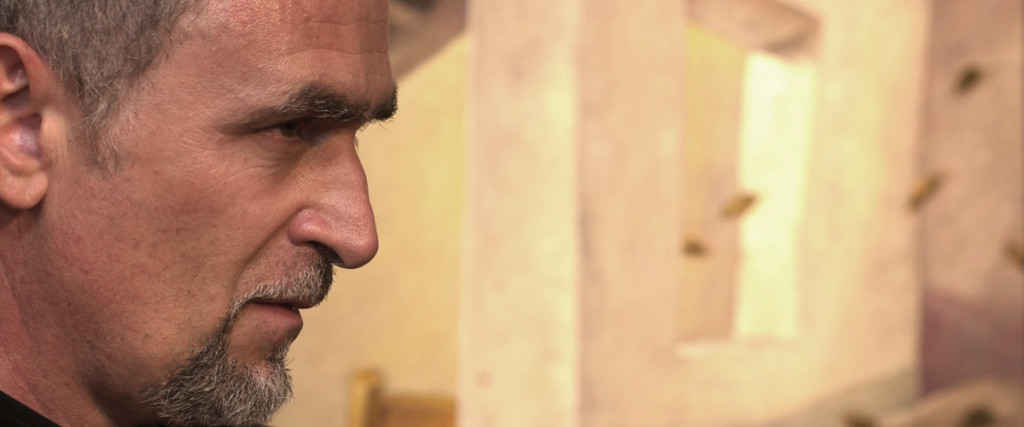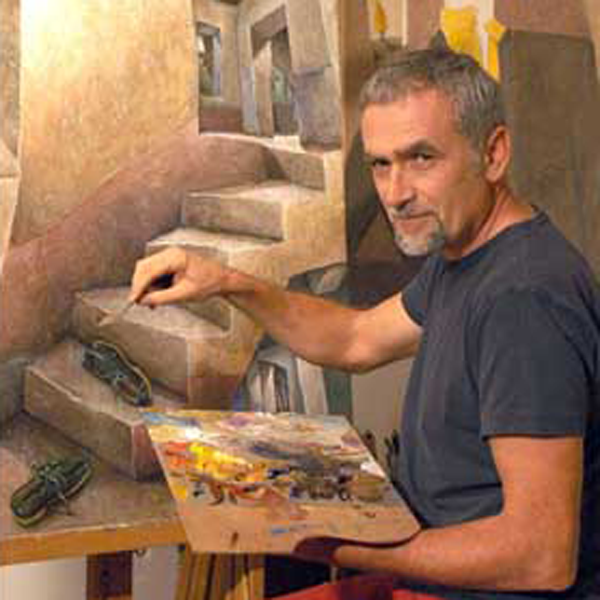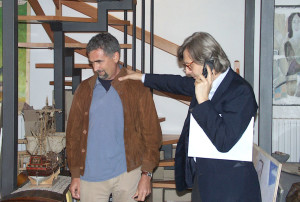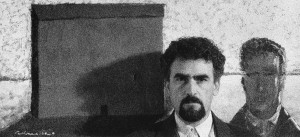
Carlo Ravaioli was from a family of sharecroppers, Coccolia, in 1954 on February the 12nd, where he would live until the age of twenty-six. The country is situated on the border between the provinces of Forlì and Ravenna, in a plain in Romagna between the hills and the Adriatic Sea.
It is a fertile and flat countryside: fruit growing, wheat, sugar beets, depending on the demands of the time.
Winters are foggy and rigid, summers are sultry. Besides the farmer’s houses there are stables and manure pits. The big cement tanks for the pulping of hemp, where boys use to bathe when the weather is hot. The families of three brothers live together in the same house, and they use to meet for meals in the kitchen on the ground floor and share the rooms and their work in the fields and with animals.
Suffering because of his frail constitution and being subject to a strict Catholic upbringing, Carlo spent most of his childhood together with his cousins who live in the same house. In the summer months the territory of the games is as extensive as the land rented to his father and uncles, where he is allowed to move freely. There are twelve acres bordered by three rivers, the river Ronco and two irrigation canals. Inside this large triangle, children can run, play, explore, climb trees. In the winter months their only hobbies are the fireplace and television at the Oratory. Charles, however, begins since childhood to show interest and skill for drawing, and more generally for small manual tasks. He models the clay, reproduces on paper the most evident elements of the landscape around him: the house, the trees, the river, carving small pieces of wood. When he was six he made his first oil painting. Later he procured the pieces and built a radio. Over time his room, only separated from the corridor by a heavy curtain, becomes a small workshop. His parents would like him to be a professional, a doctor or a lawyer; they refused artistic schools. So, after middle school, Carlo attended the high school. At that time he was a young man, lean and introverted, with a passion for the visual arts. He preferred the surrealists, especially Salvador Dali, and at the same time he begun to be interested into esotericism and devoured books on alchemy. It was not an easy time, he did not tie with classmates and tended to close. At that time, the first signs of a headache started and they will force him two years later to hospitalization in a specialized structure at the Hospital of Borgo San Lorenzo.
After graduation, mediating between his inclinations and desires of the family, he joined the faculty of architecture and moved to Florence. But something did not work, Carlo rarely attended courses and he was late in the exams. He spent his time in museums and walking around the city. He started taking photographs, and this practice will accompany him for more than two decades. During these years, the headache got worse. During the crisis, which occurred at regular intervals throughout the day, he had to remain in the dark. Because of the acute attacks he was prone to fainting. After hospitalizations, Ravaioli left the university and returned to Coccolia.
 1976 was an empty year, but his health improved. However, he did not abandon his passion for painting and when it came to know about the anatomical drawing courses held at the Rizzoli hospital in Bologna, he decided to try. During the two-year course, Ravaioli finally seems to find an environment favourable to his inclinations. In fact, it will remain his only experience of specific studies. He stood out immediately and his artwork won the first prize in a competition in his sector, and later it would be used in educational texts and communication campaigns: this recognition allowed him to gain confidence in their own ability. During the years of the course he also dedicated himself to comics, he dramatized and produced predominantly erotic strips for newspapers in vogue at the time.
1976 was an empty year, but his health improved. However, he did not abandon his passion for painting and when it came to know about the anatomical drawing courses held at the Rizzoli hospital in Bologna, he decided to try. During the two-year course, Ravaioli finally seems to find an environment favourable to his inclinations. In fact, it will remain his only experience of specific studies. He stood out immediately and his artwork won the first prize in a competition in his sector, and later it would be used in educational texts and communication campaigns: this recognition allowed him to gain confidence in their own ability. During the years of the course he also dedicated himself to comics, he dramatized and produced predominantly erotic strips for newspapers in vogue at the time.
In ’79 he was completely recovered, so he obtained the degree of anatomical illustrator and he worked for a graphic and technical design studio in Ravenna. Here Ravaioli dealt with the reproduction of posters of the Art Nouveau period. In this way he approached to Klimt decorative style, which deeply impressed him and whose influence will be easily recognized in his paintings of the following period. The following year his family moved to Villafranca , to the house inherited from his mother. It was no longer the old cottage on the river bank, but it was still the countryside landscape. Living a few kilometres from Coccolia, the sea is farther and the rose behind the ideal boundary of the Via Emilia. Here Carlo decided to continue as a graphic on his own, associating an ever more intense photographic activity. He started painting with continuity, combining techniques inherited from the comics, such as the phrases entered in the side of the figure or along the perimeter of the picture, with other techniques derived from Klimt, such as the use of gold, the borders, certain modes of composition of the figures . The awards for his artworks became more frequent. As a graphic he acquired customers and he was invited to work with various advertising agencies. As a photographer he was required in the clubs of his region for the peculiarity of his work. His paintings were exhibited in group and received appreciation. One aspect is common to all of his works: a very careful approach to the technical aspects of the labor, to the new technological supports available and at the same time a stubborn maintaining or even a recovery of the most manual operations . So, he quickly learned computer graphics (in fact, later he will draft the paintings on graphic tablets), continuing to prepare the colours by mixing oxides and earths.
The eighties also mark a tighter comparison with the masters. Ravaioli attends exhibitions, he begins a deep examination of his own work. During a period of doubt and intolerance for his previous paintings, his attention stops on Amedeo Modigliani. Ravaioli spied his works, he dedicated paintings that represent a direct tribute to the master, and begun from him to think about a new painting. In fact, for some years the influence of Modigliani remained perceptible in the representation of the figures. But it is only a starting point. in In ’94, after transferring his activity as a graphic to Forlì, Carlo Ravaioli moved away from photography and spent more time painting. He studied the Italian Novecento, Casorati, Carra, Saetti the De Chirico’s estranging atmospheres. Then he started a very personal path. He focused on the most intimate issues for him and walked on paths that he aims to define in advance, pondering them carefully. He refined his distance from the object of his work to get the exact fit for the representation that interested him, his original measure. At the time, painting had become his main interest. In 1996, he spent just a half day working as a graphic designer dedicating himself more intensely to painting.
In 98 his first solo exhibition was staged at the oratory of S. Sebastiano in Forlì. It represented the birth of the painter we know today.

